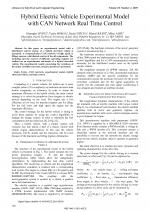| 2/2010 - 18 |
Hybrid Electric Vehicle Experimental Model with CAN Network Real Time ControlLIVINT, G. |
| Extra paper information in |
| Click to see author's profile in |
| Download PDF |
Author keywords
CAN network, experimental model, hybrid electrical vehicle, real time control
References keywords
electric(8), hybrid(7), canopen(7), ratoi(6), protocol(6), horga(6), control(6), vehicle(5), livint(5), distributed(5)
Blue keywords are present in both the references section and the paper title.
About this article
Date of Publication: 2010-05-31
Volume 10, Issue 2, Year 2010, On page(s): 102 - 107
ISSN: 1582-7445, e-ISSN: 1844-7600
Digital Object Identifier: 10.4316/AECE.2010.02018
Web of Science Accession Number: 000280312600018
SCOPUS ID: 77954632077
Abstract
In this paper an experimental model with a distributed control system of a hybrid electrical vehicle is presented. A communication CAN network of high speed (1 Mbps) assures a distributed control of the all components. The modeling and the control of different operating regimes are realized on an experimental test-bench of a hybrid electrical vehicle. The experimental results concerning the variations of the mains variables (currents, torques, speeds) are presented. |
| References | | | Cited By «-- Click to see who has cited this paper |
| [1] H. Boterenbrood, "CANopen high-level protocol for CAN-bus", NIKHEF, Amsterdam March 20, 2300, Versiunea 3.0.
[2] S. Comigan, "Introduction to the Controller Area Network (CAN)", Texas Instruments Application Report, SLOA101-August 2002, pp. 1-16. [3] V. R. Chacko, V.Z. Lahaparampil, V. Chandrasekar, "CAN based distributed real time controller implementation for hybrid electric vehicle", 0-7803-9280-9-05/2005IEEE, 247- 251. [4] J. Duan, J. Xiao, M. Zhang, "Framework of CANopen Protocol for a Hybrid Electric Vehicle", Proceedings of the IEEE Intelligent Vehicles Symposium Istanbul, Turkey, June 13-15, 2007. [CrossRef] [SCOPUS Times Cited 10] [5] Gh. Livint, R. Gaiginschi, V. Horga, R. Drosescu, G. Chiriac, M. Albu, M. Ratoi, I. Damian, M. Petrescu, "Vehicule electrice hibride", Casa de Editura Venus, Iasi, 2006. [6] Siemens, Sinamics, S120 Control Unit and additional system components, 03, 2007 Edition. [7] CANopen User Manual, Software Manual, July 2004, PHYTE Technology Holding Company [8] Gh. Livint, V. Horga, M. Ratoi, "Distributed control system for a hybrid electric vehicle implemented with CANopen protocol" - Part I, Bulletin of the Polytechnic Institute of Iasi, tom LIV (LVIII), FASC. 4, 2008, ISSN 1223-8139, pp. 1019-1026 [9] Gh. Livint, V. Horga, M. Ratoi , M. Albu, M. Petrescu, G. Chiriac, "Distributed control system for a hybrid electric vehicle implemented with CANopen protocol" - Part II, Bulletin of the Polytechnic Institute of Iasi, tome LIV (LVIII), FASC. 4, 2008, ISSN 1223-8139, pp.1027-1032 [10] Gh. Livint, V. Horga, M. Ratoi, I. Damian, M. Albu M.,G. Chiriac, "Advanced real rime control algorithms for hybrid electric vehicles optimization", CEEX Program, Simpozion "Contributii Stiintifice", UCP AMTRANS, noiembrie 2008, pp. 209-214 [11] Gh. Livint, V. Horga, M. Ratoi, M. Albu, G. Chiriac "Implementing the CANopen protocol for distributed control for a hybrid electric vehicle", Proceedings The 8th International Symposium on Advanced Electromechanical Motion Systems, Lille, July 1-3, 2009 , CD., ISBN: 978-2-915913-25-5/EAN: 978291591325 [12] M. Ehsani, Y. Gao, S.E. Gay, A. Emadi, "Modern Electric, Hybrid Electric, and Fuel Cell Vehicles", CRC PRESS, 2005, ISBN 0-8493-3154-4 [13] V. Horga, I. Doroftei, M. Ratoi, "CANopen protocol for the distributed control of an omnidirectional mobile robot", European Journal of Mechanical and Environmental Engineering, Volume 2010, Issue 1. Web of Science® Citations for all references: 0 SCOPUS® Citations for all references: 10 TCR Web of Science® Average Citations per reference: 0 SCOPUS® Average Citations per reference: 1 ACR TCR = Total Citations for References / ACR = Average Citations per Reference We introduced in 2010 - for the first time in scientific publishing, the term "References Weight", as a quantitative indication of the quality ... Read more Citations for references updated on 2025-06-01 13:50 in 9 seconds. Note1: Web of Science® is a registered trademark of Clarivate Analytics. Note2: SCOPUS® is a registered trademark of Elsevier B.V. Disclaimer: All queries to the respective databases were made by using the DOI record of every reference (where available). Due to technical problems beyond our control, the information is not always accurate. Please use the CrossRef link to visit the respective publisher site. |
Faculty of Electrical Engineering and Computer Science
Stefan cel Mare University of Suceava, Romania
All rights reserved: Advances in Electrical and Computer Engineering is a registered trademark of the Stefan cel Mare University of Suceava. No part of this publication may be reproduced, stored in a retrieval system, photocopied, recorded or archived, without the written permission from the Editor. When authors submit their papers for publication, they agree that the copyright for their article be transferred to the Faculty of Electrical Engineering and Computer Science, Stefan cel Mare University of Suceava, Romania, if and only if the articles are accepted for publication. The copyright covers the exclusive rights to reproduce and distribute the article, including reprints and translations.
Permission for other use: The copyright owner's consent does not extend to copying for general distribution, for promotion, for creating new works, or for resale. Specific written permission must be obtained from the Editor for such copying. Direct linking to files hosted on this website is strictly prohibited.
Disclaimer: Whilst every effort is made by the publishers and editorial board to see that no inaccurate or misleading data, opinions or statements appear in this journal, they wish to make it clear that all information and opinions formulated in the articles, as well as linguistic accuracy, are the sole responsibility of the author.



